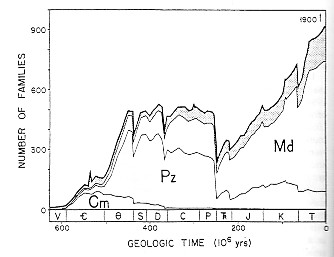
Nowadays many scientists blame the death of the dinosaurs on an asteroid impact about 65 million years ago. This asteroid was about 10 kilometers in diameter, and it slammed into shallow waters covering what is now the Yucatan peninsula. The resulting crater, called Chicxulub or "Tail of the Devil", is about 150 kilometers across! The resulting tsunami would have hit Texas with a wave 50 to 100 meters high. Millions of tons of material were hurled into the atmosphere, causing wildfires across the world as they landed. Rocks called "tektites" formed from droplets of molten quartz can be found as far as Wyoming. A layer of dust from the impact can be found in rocks world-wide, marking the boundary between the Cretaceous and Tertiary. Scientists guess that this dust made it too dark to see for 1 to 6 months, and too dark for photosynthesis for sometime between 2 months and a year. Carbon dioxide released from heated limestone would have also had effects on the climate.
But this disaster at the end of the Cretaceous was only one of the 5 big extinctions life on Earth has suffered throughout the Phanerozoic eon, which began with the Cambrian period 540 million years ago. You can see the "Big Five" as sudden declines in this graph of biodiversity:

In the above graph, created by an expert on the statistics of mass extinctions named John J. Sepkoski Jr., families have been divided into Cambrian (Cm), Paleozoic (Pz), and Modern (Md) fauna. What really matters for us, though, are the five biggest dips! These are the "Big Five":
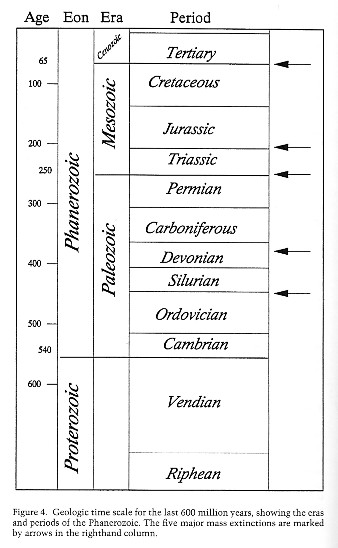
This was the second biggest extinction of marine life, ranking only below the Permian extinction. There was only life in the seas at this time, and more than one hundred families of marine invertebrates died, including two-thirds of all brachiopod and bryozoan families. One theory is that as the continent Gondwana drifted over the south pole, there was a phase of global cooling, and so much glaciation took place that sea levels were drastically lowered.
By this point there were plants, insects and amphibians on land, fish in the seas, and huge reefs built by corals and stromatoporoids. The continents of Uramerica and Gondwana were just beginning to move together to form Pangea. The extinction seems to have only affected marine life, but 70% of marine species went extinct! Reef-building organisms were almost completely wiped out, so that coral reefs returned only with the development of modern corals in the Mesozoic. Brachiopods, trilobites, and other sorts got hit hard. Since warm water species were the most severely affected, many scientists suspect another bout of global cooling. There may have also been a meteorite impact, but it seems this extinction was not a sudden event.
At the end of the Permian there was one supercontinent, Pangea. There were many sorts of reptiles and amphibians on land, together with many plants, especially ferns but also conifers and gingkos. There were also complicated coral reef ecologies undersea. After the extinction, we mainly see fossils of one species of reptile on land: a medium-sized herbivore called Lystrosaurus. We also mainly see fossils of just one species of sea life, a brachiopod called Lingula. Eventually other species seem to reappear - the so-called "Lazarus taxa", named after the Biblical character who returned from the dead. Clearly they must have survived the extinction event, but in very low numbers.
This was the largest disaster that life has ever yet faced on our planet. Before it happened, the seabeds near China looked something like this:
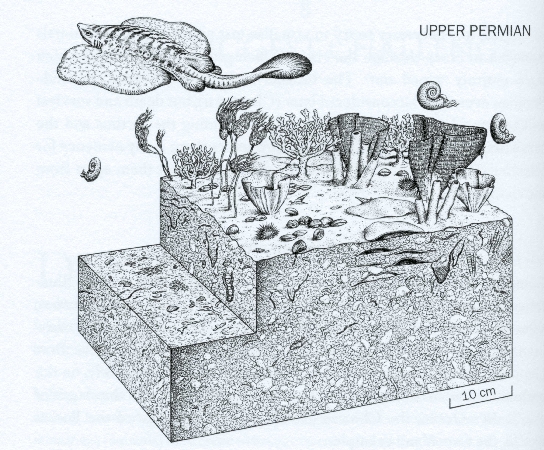
After it happened, they looked like this:
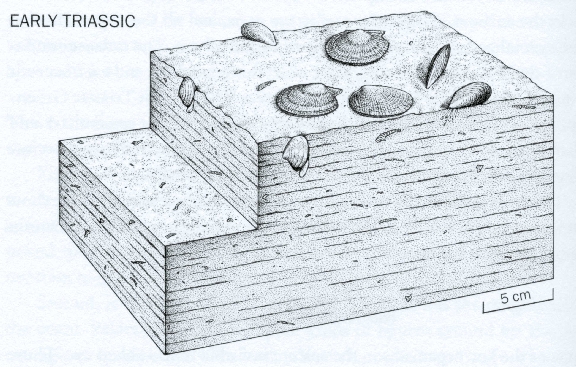
Pretty sad, eh? Some people estimate that perhaps 90% or even 95% of all species went extinct! (The figure of 83% above comes from some papers by Sepkoski, who tried to calculate the number of families and genera that died out in each of the Big Five extinctions. Take all these numbers with a grain of salt.)
It took about 50 million years for life on land to fully recover its biodiversity, with the rise of many species of dinosaurs. Nothing resembling a coral reef shows up until 10 million years after the Permian extinction, and full recovery of marine life took about 100 million years.
The causes remain controversial: some scientists blame an asteroid impact, while others blame severe global warming and a depletion of oxygen in the atmosphere due to prolonged massive volcanic eruptions in Siberia - we see signs of these in lava beds called the "Siberian traps". On the other hand, Benton and others argue that the rise of carbon in the atmosphere at this time is only explicable if there was also a catastrophic release of methane from gas hydrates under the ocean.
Never heard of "gas hydrates"? Hmm, they're interesting! Even today there is a huge amount of methane and other gases trapped in ice on the ocean floor! These so-called "gas hydrates" contain about 10,000 billion tons of carbon - twice as much as in all the fossil fuels on Earth. If this ever gets released in a giant "methane burp", we could be in trouble - this mechanism may have caused more than one drastic climate change. Some people have proposed mining this methane for fuel. But others have suggested stuffing carbon dioxide down there as a way to fight against the rise of greenhouse gases. This is called "sequestration" - and as you can see in my economics diary, the chairman of Shell thinks it's the only way to save the world from global warming.
But I digress...
By the end of the Triassic there was again a variety of reptiles on land and in sea. But the reptiles were completely different from those at the end of the Permian, and the biodiversity had not completely recovered: for example, there were no truly large predators. There were primitive conifers and gingkos; ferns were not so dominant as before. There were also frogs, lizards, and even the first mammals.
The extinction at the end of the Triassic destroyed about 20% of all marine families, many reptiles, and the last of the large amphibians - opening niches for the dinosaurs of the Jurassic. The cause of this extinction remains obscure, but it's worth noting that this was about the time when the supercontinent Pangea began splitting into Laurasia and Gondwanaland, with massive floods of lava in the Central Atlantic Magmatic Province - perhaps one of the largest igneous events in the earth's history.
By the Cretaceous there were dinosaurs and flowering plants on land, many new insects taking advantage of the flowering plants, and modern fish. Continents were beginning to resemble the current configuration. In the disaster at the end of this period all the dinosaurs died out, as well as many species of plants, diatoms, dinoflagellates, ammonoids, brachiopods, and fish. Often called the "KT" extinction, this was the smallest of the Big Five - it's mainly interesting because it led to the rise of mammals, and in particular, us. As explained above, many scientists believe this extinction was due to an asteroid impact at Chicxulub. Another popular theory is that it was caused by the enormous volcanic eruptions which formed the lava beds in India known as the "Deccan Traps". Either way, we know it took 10 million years for biodiversity to recover from this mass extinction.
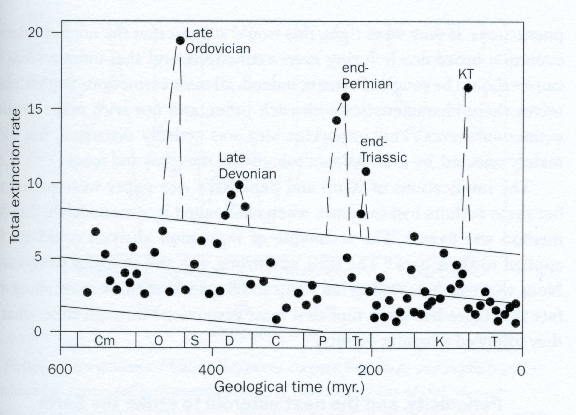
The advantage of working with marine life, by the way, is that it's much more likely to get fossilized than life on land.
Another fascinating feature of the above graph is the general downwards trend in the rate of extinction: the middle line is the average rate, while the two outlying lines represent a 95% confidence interval. So, perhaps life is getting better.
However...
We may now be in the middle of yet another mass extinction! The Pleistocene began around 1.8 million years ago, bringing with it an erratic fluctuation between ice ages and warmer periods. The latest of these ice ages ended around 8000 years ago, right around when Homo sapiens was starting to really take over the planet. Starting around 11,000 years ago, most of the large mammals went extinct: mammoths, saber-toothed tigers, dire wolves, elephant-sized ground sloths, and so on. Though there is much debate about the causes, it seems that human hunting contributed to their demise. This is called the "Pleistocene overkill hypothesis".
We're now seeing an intensification of the rate of extinctions as wilderness areas are obliterated throughout the planet. Nobody knows what the extinction rate is: since most species haven't even been catalogued yet, all we have are lower bounds. These are only close to being accurate for the biggest and most charismatic species (e.g. mammals, birds and trees), but these represent a tiny fraction of all the species that are out there. So, any reasonable guess of the extinction rate requires extrapolation. If we keep track only of recorded extinctions, the story looks like this:
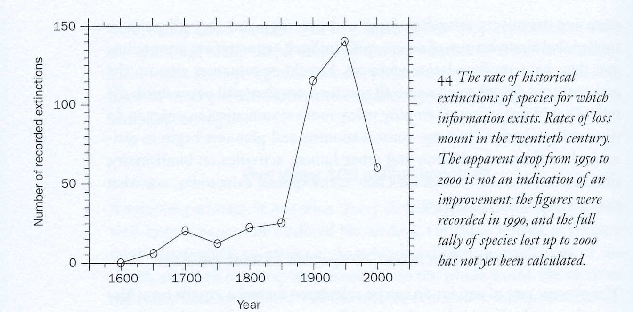
But what about all the species we haven't even catalogued yet?
Phillip and Donald Levin estimate that right now one species is going extinct every 20 minutes, and that half of bird and mammal species will be gone in 200 to 300 years. Richard Leakey estimates a loss of between 50,000 and 100,000 species a year, and says that only during the Big Five mass extinctions was the rate comparably high. E. O. Wilson gives a similar estimate. In his book, Michael Benton reviews the sources of uncertainty and makes an estimate of his own: given that there are probably somewhere between 20 and 100 million species in total, he estimates an extinction rate of between 5,000 and 25,000 species per year. This means between 14 and 70 species wiped out per day.
Skeptics find these numbers alarmist. For example, in Chapter 23 of this book:
In short, despite plenty of bickering, there seems to be agreement that humans are causing a vastly elevated extinction rate.
And there's also lots of other data pointing to a massive human-caused disruption of the biosphere. One in eight plant species are in danger of extinction within the next 30 years, according to the IUCN Red List of threatened species, along with one in eight bird species and a quarter of all mammals. The Audubon Society reports that 30% of North American songbird species are in significant decline. Worldwide populations of frogs and other amphibians have been declining drastically, and a recent detailed study shows that of 5743 known species of amphibians recorded in the last couple of centuries, 34 are now extinct, while another 122 are probably extinct: they can no longer be found. Even worse, of these 122 missing species, 113 have disappeared since 1980!
In the oceans, 90% of all large fish have disappeared in the last half century, thanks to overfishing. We see the spread of dead zones near the mouths of rivers, where nutrients from fertilizer create blooms of plankton leading to low-oxygen water where few organisms can survive. Coral reefs are becoming unhealthy around the world, with a strong upswing in the bleaching of reefs since the 1970s. "Bleaching" is the loss of algae called zooxanthellae which live in coral and give it its color. It seems to be caused by higher water temperatures due to global warming.
And so on, and on, and on....
So, lots of evidence suggests that are in the midst of a mass extinction. It's very different than all previous ones. I don't think we can halt it; it's governed by seemingly unstoppable demographic and economic forces. Until the configuration of these forces shifts, at best we can only ameliorate their effects. We can't save every species, but maybe we can save one from every genus, or one from every family. Every little bit helps! The Permian extinction offers a lesson of hope: from the feeblest glow life can eventually rekindle.
That's the one great thing about this crisis: even a small nudge can make the difference between extinct and not extinct. I think it's worthwhile contributing to these organizations:
so I do, but there are many other ways to help - and if you have a fondness for a particular kind of animal or plant, there's probably an organization out there working to save it. Tigers? Gorillas? Birds? Take your pick... they're going fast.
The figures on families and genera that went extinct in the Big Five extinctions came from these papers:
I copied the graph of the mass extinction rate from Benton's book, but it originally came from this paper:
© 2006 John Baez
baez@math.removethis.ucr.andthis.edu